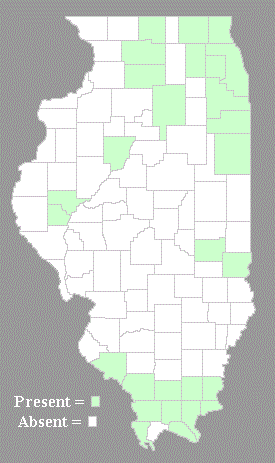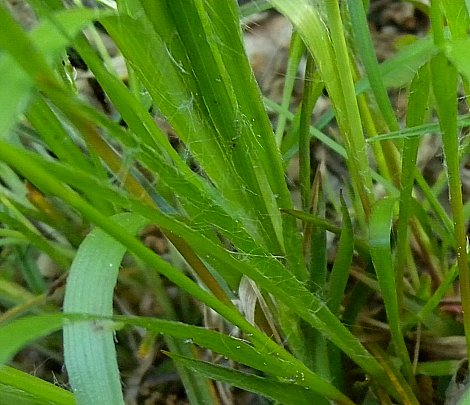
Each culm terminates in an umbel of 3-12 flower clusters. The rays (floral stalks) of this umbel are nearly zero to 3" long and erect to ascending; they are straight, light green, and terete. The rays are divergent by less than 60º. Individual flower clusters are 6-13 mm. long and 5-6 mm. across; they are usually short-cylindric in shape, consisting of a dense cluster of 6-16 flowers. Each flower consists of 6 scaly tepals, 6 stamens, and a pistil. The tepals are 2.5-4.0 mm. in length and lanceolate in shape; they are initially light green to brownish yellow, becoming light to dark brown with age. However, the margins of the tepals are white-membranous. At the base of each flower or flower cluster, there are one or more chaffy bractlets that are less than 3 mm. in length. At the base of the inflorescence, there is a leafy bract up to 2" long, resembling a small leaf blade. The blooming period occurs during mid- to late spring, lasting about 1-1½ weeks. The flowers are cross-pollinated by the wind.
 Afterwards, the ovaries
develop into seed capsules that
are a little shorter than the tepals. These capsules are
obovoid-globoid and somewhat 3-lobed longitudinally, terminating
abruptly into a very short beak. At maturity, each capsule splits open
into 3 sections from the top, releasing 3 seeds. These seeds are small
and light enough to be blown about by the wind. Individual seeds are
about 1.5 mm. in length (excluding their food appendages), broadly
ellipsoid in shape, and dark brown. Attached to one end of each seed,
there is a white food appendage about 0.5 mm. in length. The root
system is fibrous, occasionally forming clonal offsets.
Afterwards, the ovaries
develop into seed capsules that
are a little shorter than the tepals. These capsules are
obovoid-globoid and somewhat 3-lobed longitudinally, terminating
abruptly into a very short beak. At maturity, each capsule splits open
into 3 sections from the top, releasing 3 seeds. These seeds are small
and light enough to be blown about by the wind. Individual seeds are
about 1.5 mm. in length (excluding their food appendages), broadly
ellipsoid in shape, and dark brown. Attached to one end of each seed,
there is a white food appendage about 0.5 mm. in length. The root
system is fibrous, occasionally forming clonal offsets.Cultivation: The preference is partial sun, dry-mesic conditions, and soil containing some clay, rocky material, or sand. Most growth and development occurs during the cool weather of spring.
Range & Habitat: The native Common Wood Rush (Luzula multiflora) is fairly common in southern Illinois, occasional in NE Illinois, and uncommon or absent elsewhere within the state. Habitats include upland areas of hilly woodlands, edges of bluffs, areas along paths in upland woodlands, shaded rocky cliffs and rocky ledges, sandy savannas, and sand prairies. This rush is found in natural areas of moderate to high quality. Some disturbance is probably beneficial if it removes excessive shade from overhead canopy trees.
Faunal Associations: Very little is known about floral-faunal relationships for this species. Because the seeds have food appendages, they are carried about by ants and possibly other insects. These insects help to spread the seeds to new locations.
Photographic Location: A sandy savanna at Indiana Dunes State Park in NW Indiana.
Comments: Common Wood Rush (Luzula multiflora) resembles a grass in its vegetative state, but its seeds and scaly tepals are similar to those of other species in the Rush family (Juncaceae). It is also unusual in preferring upland woodland habitats, as most species in the Rush family prefer habitats that are more wet and sunny.

The taxonomy of the Wood Rush complex involving several Luzula spp. has a history of instability. In the past, Common Wood Rush was classified as a variety of a European species, or Luzula campestris multiflora. This rush is also considered a distinct species, Luzula multiflora, but in the past it was lumped together with another similar species, Luzula echinata (Hedgehog Wood Rush). As a result, Luzula multiflora and Luzula echinata are sometimes confused. The latter species can be distinguished by the more divergent rays of its umbels (exceeding 60º), which can be erect, ascending, widely spreading, or declining. In addition, the flower clusters of the latter species are more flattened (often more wide than tall) and each of these clusters usually contain fewer flowers (typically 3-8). Another species, Luzula bulbosa (Bulbous Wood Rush), was also assigned to the Wood Rush complex, but it is now considered distinct. This last species can be distinguished by the small bulbous tubers of its root system and its seeds are usually smaller in size (typically about 1.0 mm. in length, excluding the food appendages). All of these species are native to Illinois and they can be found in similar habitats.